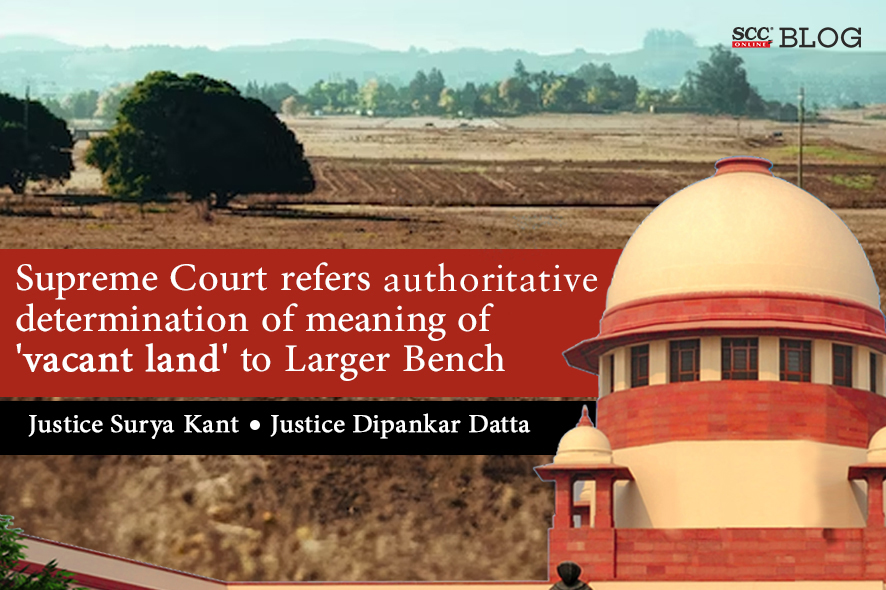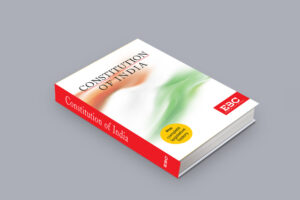Supreme Court: In a matter requiring the Court to consider the true construction, meaning and import of the expression ‘vacant land’ contained in Section 2(q) of the Urban Land (Ceiling and Regulation) Act, 1976 (‘Ceiling Act’) with special reference to Section 2(i), the Division Bench of Surya Kant and Dipankar Datta, JJ. Expressed that the said provisions required authoritative determination of related issues by a Larger Bench
The Court pointed out that “Notwithstanding the fact that ‘urban land’ or any regulatory measures in relation thereto fall within the exclusive domain of a State Legislature in terms of Entry 18 of List II—State List under the Seventh Schedule of the Constitution, the Ceiling Act was enacted by Parliament, in exercise of its powers under Article 252 of the Constitution for which as many as 11 States passed a Resolution authorising the Parliament to enact a law imposing a ceiling on urban property, more so after the imposition of a ceiling on agricultural lands in most of the States.”
It was stated that the Ceiling Act was enacted to provide for imposition of a ceiling on ‘vacant land’ for regulation of building construction on such lands and prevention of concentration of urban land in specific hands, etc. The Court perused the legislative scheme of the Ceiling Act, particularly the Sections regarding imposition of ceiling limit, categorization of limits, statements thereunder, acquisition by the State Government, notification as excess land, receipt of payment by landowner expropriated of the ‘vacant land’ and certain exceptions.
Factual Matrix
The appellants purchased a property on 11-07-1974 and applied to Calcutta Municipal Corporation (‘CMC’) seeking sanction of building plan. CMC issued notice on 23-08-1974 requiring the appellants to comply with certain requirements. While appellants claimed to have furnished the required information on 17-10-1974, CMC neither sanctioned nor rejected the building plan within the stipulated period. The Ceiling Act came into force on 17-10-1976 and was applicable on State of West Bengal by virtue of Section 1(2), and Kolkata City fell within category ‘A’ Schedule 1 of Section 4(1) of the Ceiling Act providing for ceiling limit of 500 sq.m.
The appellants filed a statement under Section 6(1) of the Ceiling Act and also applied for exemption under Sections 4(3) and 20 of the Ceiling Act for construction of a Group Housing Scheme. The Competent Authority issued a draft statement under Section 8 on 30-04-1979 showing retainable land as 699 sq.m. and 3115.50 sq.m. was determined as `vacant land’. A notification was issued on 7-11-1979 under Section 10(1) followed by a declaratory notification under Section 10(3) on 5-01-1980, whereby land measuring 2929 sq.m. was held to be ‘excess vacant land’ with effect from 16-01-1980 and which was deemed to have been acquired by the State Government. Thereafter, the State Government issued a notice under Section 10(5) of Ceiling Act on 4-03-1980 asking the appellants to deliver possession of ‘vacant land’.
Appellants challenged the State’s declaration of ‘vacant land’ before High Court, wherein, the parties were directed to maintain status quo on 15-04-1980, but the writ petition was dismissed by the Single Judge on 25-06-1987. This was followed by appellants filing an intra-court appeal in which, ad interim order was allowed to continue, and the appeal was dismissed on 19-05-2011. They approached the Supreme Court and the parties were directed to maintain status quo on 21-11-2011 and not to create 3rd party rights or change the nature and character of the property.
It was contended that the procedure of calculating ‘excess vacant land’ adopted by the Competent Authority was derogatory to Section 2(q)(i) and 2(q)(ii) read with Clause 20(2) of the Building Regulations notified under the Calcutta Municipal Corporation Act, 1951.
Court’s Analysis of ‘Vacant Land’
The Court pointed towards the admitted fact of appellants declaring the entire piece of land as ‘vacant land’ in their statement under Section 6(1) of Ceiling Act, but in the objection against draft statement claimed existence of a structure, the area of which was liable to be excluded from ‘vacant land’ in view of Section 2(q)(ii) of the Ceiling Act. The Court highlighted that the objection led the Competent Authority to exclude retainable area of 500 sq.m. as per Section 4(1)(a) and declare the remaining land of 2929 sq.m. as ‘vacant land’.
Skipping on the factual question of existence of a building to exclude the said land from the permeates of a ‘vacant land’, the Court focused on the true interpretation of meaning of Section 2(q)(i) and (ii) of the Ceiling Act for determination of ‘vacant land’.
The Court cited State of U.P. v. L.J. Johnson, (1983) 4 SCC 110 to express that “Section 2(q)(i) gives a blanket exemption to any land situated in an urban area where the entire area is covered by land on which it is not permissible to raise a building. Such land will not be deemed to be ‘vacant land’ because the same cannot be used for building purposes and thus falls beyond the purview of the Act.” In Meera Gupta v. State of W.B., (1992) 2 SCC 494 also, the three-Judge Bench considered the expression ‘vacant land’, Angoori Devi v. State of U.P., (1997) 2 SCC 434 which interpreted Section 4(9) r/w Section 2(q) of Ceiling Act which was decided by a three-Judge Bench and then 5 Judge Bench in Angoori Devi v. State of U.P., (1997) 7 SCC 757 but the matter could not be heard and the Ceiling Act got repealed vide Urban Land (Ceiling and Regulation) Repeal Act, 1999.
With reference to State of Maharashtra v. B.E. Billimoria, (2003) 7 SCC 336 for analysis of Section 2(q)(i) and the decision that the provisions of a statute to be read in text and context, the Court pointed out that the lead judgment ignored Jhonson (supra), and therefore lends support to the contentions raised by the appellants in the instant matter.
The Court regarded the Ceiling Act as an expropriatory legislation wherein, ‘payment’ under Section 11 of the Act to a landowner is not fair and just market value of the surplus vacant land and batted for principles of strict construction and recommended that Section 2(g) and 2(q) also deserve special attention but were not explicitly discussed in the cases cited. The Court opined that the interpretation, spirit and object of the Ceiling Act as envisaged during enactment and juxtaposed against the regressive impact experienced in different States as indicated in Statement of Objects and Reasons of the Repeal Act required authoritative determination of related issues by a Larger Bench and accordingly sought the Chief Justice of India for appropriate directions in this regard.
[Kewal Court (P) Ltd. v. State of W.B., 2023 SCC OnLine SC 1279, decided on 9-10-2023]
Judgment authored by: Justice Surya Kant
Advocates who appeared in this case :
For Appellants: Advocate Rajat Sehgal, Advocate Rashi Rampal, Advocate on Record Vikas Mehta, Advocate Samyak Jain
For Respondents: Advocate on Record Madhumita Bhattacharjee, Advocate Urmila Kar Purkayastha, Advocate Srija Choudhury, Advocate on Record L. C. Agrawala, Advocate Pankaj Agarwala, Advocate Reena Pandey, Advocate Gautam Barua, Advocate on Record Anurag Pandey, Advocate on Record Chira Ranjan Addy








